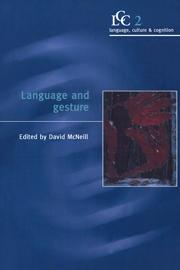Book contents
- Frontmatter
- Contents
- Acknowledgments
- Introduction
- Part 1 Gesture in action
- Part 2 Gesture in thought
- Part 3 Modeling gesture performance
- Part 4 From gesture to sign
- 16 Blended spaces and deixis in sign language discourse
- 17 Gestural precursors to linguistic constructs: how input shapes the form of language
- 18 Gesture to sign (language)
- Index
16 - Blended spaces and deixis in sign language discourse
Published online by Cambridge University Press: 07 January 2010
- Frontmatter
- Contents
- Acknowledgments
- Introduction
- Part 1 Gesture in action
- Part 2 Gesture in thought
- Part 3 Modeling gesture performance
- Part 4 From gesture to sign
- 16 Blended spaces and deixis in sign language discourse
- 17 Gestural precursors to linguistic constructs: how input shapes the form of language
- 18 Gesture to sign (language)
- Index
Summary
Introduction
It is abundantly clear that gestures constitute a highly significant, often indispensable, aspect of spoken language discourse. Can the same be said of sign language discourse, where signs themselves are produced by gestures of the hands, arms, and body? Does sign language discourse make use of spontaneous gestures, distinguishable from lexical signs, that convey meanings such as those conveyed by gesture in spoken language discourse? I will argue that it does. Although I focus on deictic gestures, it will become apparent that sign language discourse also includes gestures in which the actions of the signer illustrate the actions of one of the characters in a narrative. Mental-space theory (Fauconnier 1994, 1997) provides the conceptual structures needed for constructing meaning from the linguistic signal and has been employed to successfully solve numerous previously intractable linguistic problems. Phenomena such as metonymy, reference, co-reference, and presupposition have all been shown to depend on mental-space configurations. I will argue that mental spaces are also essential in understanding the significance of the gestural signal. I will begin by describing the production of signs in some detail. Understanding the nature of the articulation of the signed signal is essential in making the distinction between articulatory gestures of the hands equivalent to gestures of the tongue in the production of speech and other types of spontaneous, nonlexical gestures. Next I will provide a brief history of the treatment of space in the analysis of ASL. The gestures I will treat as pointing gestures have been previously analyzed as ordinary linguistic, articulatory movements.
- Type
- Chapter
- Information
- Language and Gesture , pp. 331 - 357Publisher: Cambridge University PressPrint publication year: 2000
- 18
- Cited by

